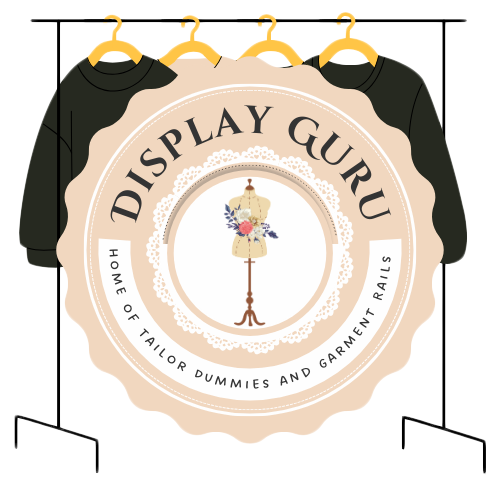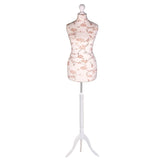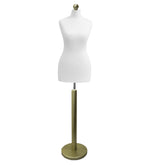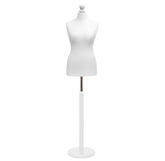Your Ultimate Guide to Adjustable Dressmaker Dummies
Think of an adjustable dressmaker dummy as a stand-in for the human body, a customisable torso that lets sewers and designers craft garments with a perfect fit. It's the key to letting you drape fabric, pin patterns, and assess fit without needing a live model on hand.
Why a Dressmaker Dummy Is Your Secret Weapon
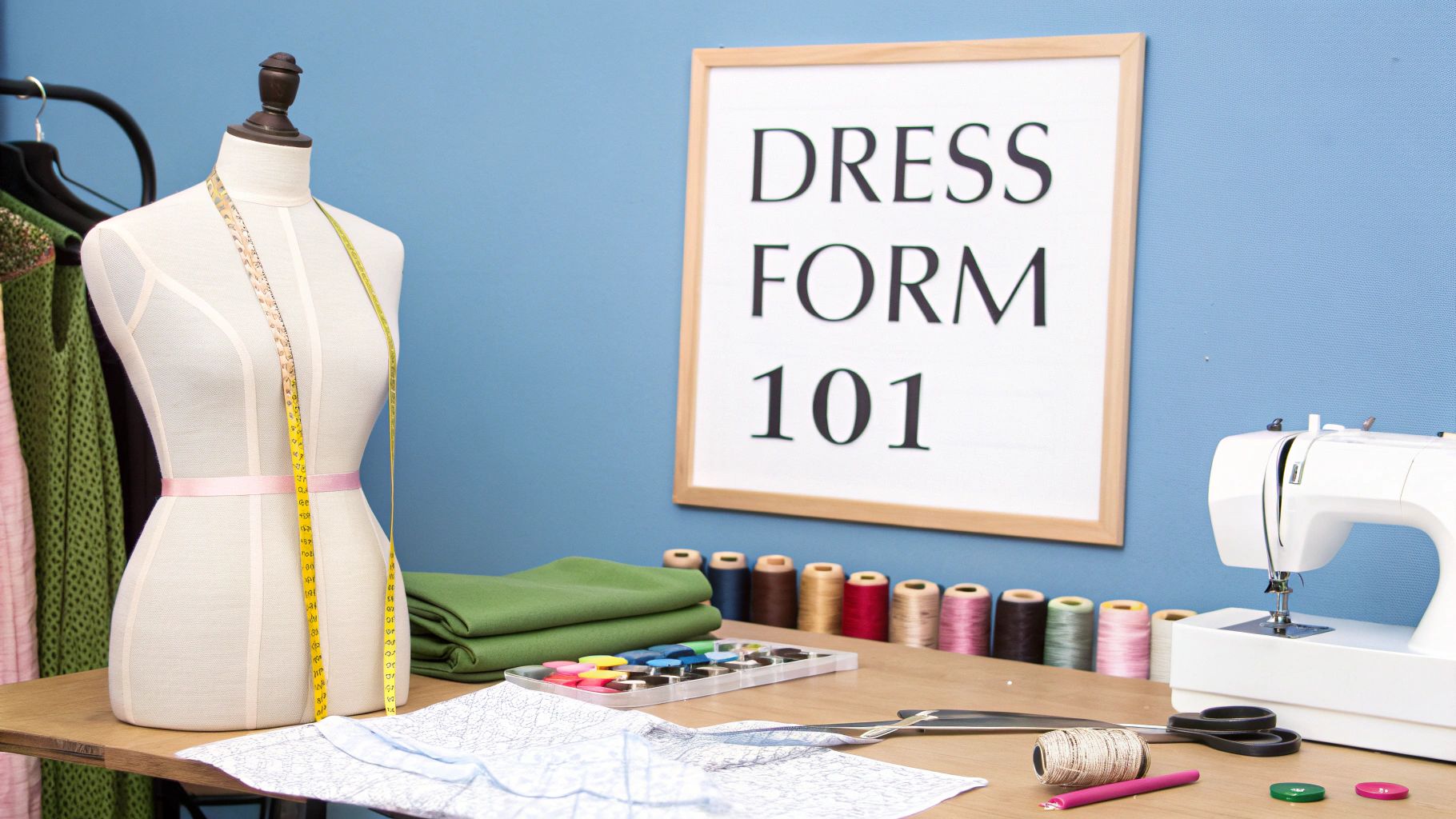
Imagine being able to sculpt fabric directly onto a replica of a person's shape, transforming a flat piece of paper into a three-dimensional masterpiece. That’s exactly the power a dressmaker dummy brings to your sewing space. It’s your silent partner, always ready to help you perfect your creations with incredible precision.
It closes the gap between a 2D paper pattern and the true curves of the body. In a way, it’s like the armature for your fabric sculptures, giving you the structure needed to get a professional fit that's almost impossible to achieve when working flat. Today’s adjustable dummies have come a long way from the static mannequins of the past, evolving into the versatile, indispensable tools they are now.
The Professional Edge in Your Studio
For anyone who’s serious about making clothes, a dummy isn't just a nice-to-have item; it's a fundamental piece of kit. It offers a consistent, unchanging form to work on, which is vital for getting the symmetry and balance of your designs just right. Unlike a human model, a dummy never gets tired, never fidgets, and is available around the clock.
This reliability completely changes how you work. For example, you can:
- Check the hang and drape of a fabric from every possible angle.
- Pin and tuck darts with much greater accuracy.
- Mark hemlines evenly all by yourself.
- Visualise the final garment as a complete piece right from the start.
An adjustable dressmaker dummy lets you see your work in 3D, helping you spot fitting issues long before you cut into your final fabric. This shift from flat-pattern drafting to three-dimensional design is a true game-changer for quality.
Here in the UK, these tools are central to the world of professional pattern cutting and tailoring. Their real value is in how closely they can mimic real body shapes, with features like height adjustment and pinnable surfaces being absolutely vital for accurate fitting. You can explore more about professional dress form standards to see why they are considered a tailor's best friend. This kind of precision, once only found in couture houses, is now readily available to home sewers, raising the bar for everyone.
Getting to Know Your Sewing Form
To really get the most out of your adjustable dressmaker dummy, you have to understand how it’s put together. Think of it like a musical instrument – once you know what each part does, you can make everything work in harmony. Every component, from the torso down to the stand, has a job to do in helping you create that perfect, custom silhouette for your sewing projects.
The torso is where all the magic happens. It's the command centre for your sizing, housing the adjustment mechanisms that let you sculpt the form to match specific measurements. Getting to grips with how these systems work is the first step in choosing the right dummy for you.
How the Adjustments Work
Most adjustable dummies rely on a system of dials. You’ll find these little wheels or keys dotted across the bust, waist, and hip areas. As you turn them, the corresponding sections of the torso expand or retract. It’s a beautifully simple system that gives you incredible control, letting you make tiny, precise changes.
Some models use what’s called an auto-set mechanism. With this type, a single key or button moves several sections at once. It’s definitely faster, but you do trade some of that fine-tuned control over individual measurements.
- Rotating Dials: These are the classic and most popular choice. They give you pinpoint accuracy over the bust, waist, and hips, which is brilliant for accommodating asymmetrical body shapes.
- Key-Operated Systems: A single key turns multiple gears simultaneously, speeding up the overall adjustment process.
- Snap or Latch Systems: You'll find these on some dummies. They click into predefined positions, which is quick but offers less flexibility than a smooth dial.
At its heart, an adjustable dummy is a mechanical sculpture. The dials and internal gears work together like a complex skeleton, allowing the 'skin' or outer form to expand and contract to match the measurements you need.
The All-Important Supporting Features
It’s not just about the dials, though. A few other features really make or break a dummy’s usefulness. The stand, for example, is your foundation. It needs to be rock-solid. Most are either tripod-style or have a heavy, flat base, and almost all of them are height-adjustable. This is non-negotiable for working on everything from a cropped top to a floor-length gown. Trust me, nothing is more frustrating than a wobbly stand when you’re trying to drape fabric.
Another brilliant feature to look out for is a hem marker. This is a small guide that clips onto the central pole and swivels around. It lets you mark a perfectly straight and even hemline on a skirt or dress – a job that’s almost impossible to get right on your own.
Here in the UK, the range of adjustable dressmaker dummies has expanded to cater for all sorts of body shapes. Popular models, like the 'Dritz adjustable dress form', are covered in multiple wheels at key points, offering detailed adjustments that are perfect for home sewers and professional designers alike. For more on this, have a look at this great article on the best dressmaking mannequins on Gathered.how. Getting these dials set up correctly is absolutely crucial, and our guide on how to take mannequin measurements can give you a few extra pointers.
How to Choose the Right Dressmaker Dummy
Choosing the right adjustable dressmaker dummy is a real milestone for any sewer. It’s an investment in your craft, and the right one can completely change the game, helping you get that perfect fit you’ve been chasing. But with so many options out there, it’s easy to feel a bit lost.
The trick is to think of it less like a purchase and more like hiring a silent, very patient assistant. You need one that’s reliable, flexible, and perfectly suited to the kind of sewing you do. Your ideal dummy really comes down to three things: your projects, your body, and your budget.
Your Measurement Range Is the Starting Point
Before you even start browsing, find your tape measure. The single most important factor is finding a dummy whose adjustment range comfortably includes your own bust, waist, and hip measurements.
Here’s a golden rule: always choose a form that’s slightly smaller than you. You can easily add padding to build up specific areas—like a fuller bust or rounded hips—but you can never make a dummy smaller than its minimum settings.
For instance, if your bust is 99 cm, look for a model where 99 cm is somewhere in the middle of its range, not right at the upper limit. This gives you some wiggle room if your own measurements change over time.
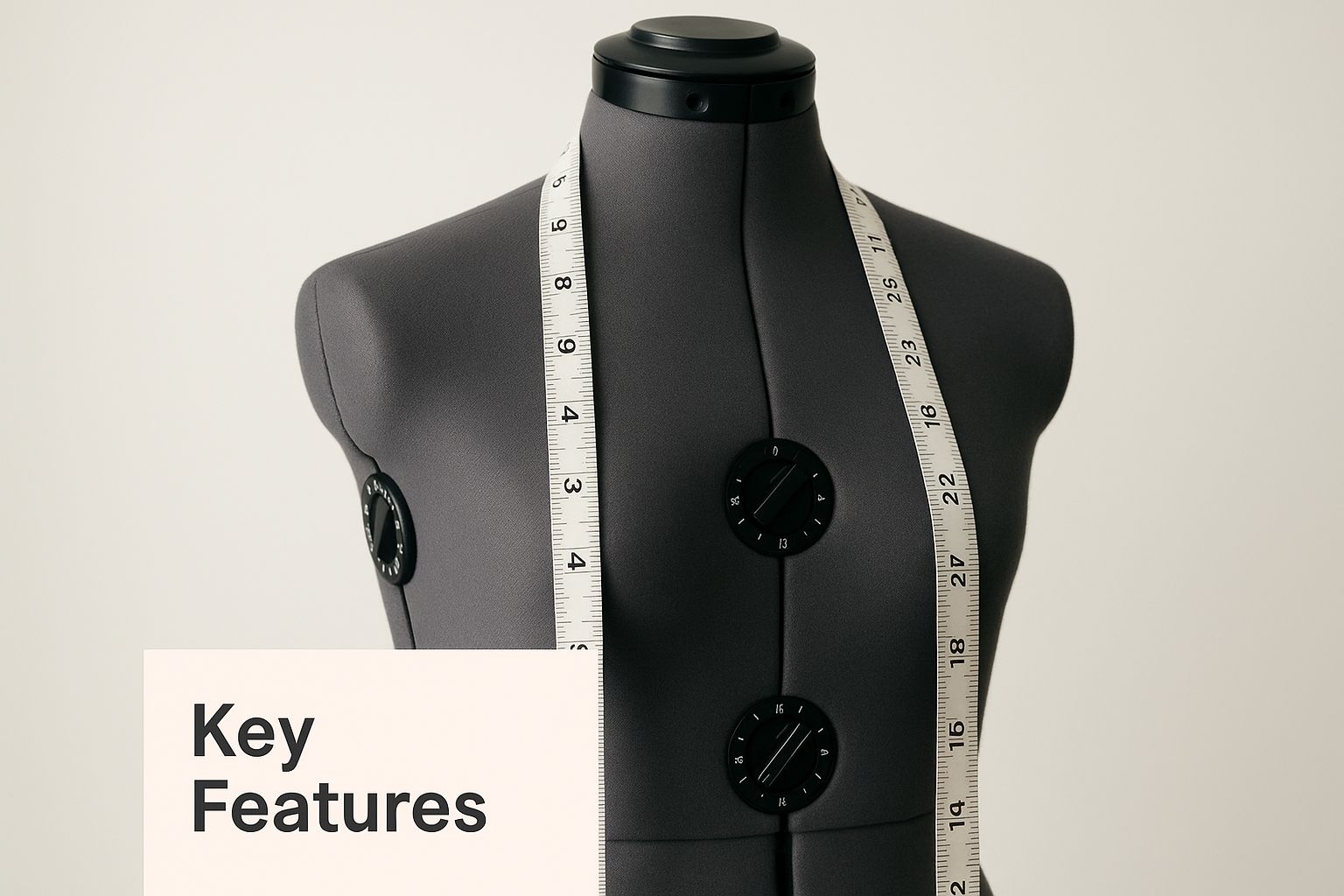
As you can see, a combination of multiple adjustment dials and a pinnable surface is what truly lets you customise the fit for professional-level work.
Consider Your Projects and Pinnability
So, what are you planning to make? The answer will point you toward the right features and materials.
- For Draping and Pattern Making: A fully pinnable surface is an absolute must. You need a dummy with a foam-backed body that you can stick pins into easily and securely. Hard plastic models just won’t cut it for this kind of hands-on design work.
- For Fitting and Alterations: To truly mirror a human body’s curves, you’ll want a good number of adjustment points. Look for at least 8 to 12 dials, as this allows for the subtle shaping needed to get a garment fitting just right.
- For Displaying Finished Garments: If you mainly want to photograph your creations or display them, a simpler, less adjustable model might do the trick. That said, a fully functional dummy is always the more versatile option.
Picking a dress form is all about finding the balance between what you need right now and where you want to go with your sewing. A hobbyist might be happy with an entry-level model, but a fashion student should really invest in a professional form that can keep up as their skills grow.
Comparing Adjustable Dressmaker Dummy Types
To help you visualise the options, here’s a quick breakdown of what you can expect from different types of dress forms available in the UK.
| Feature | Entry-Level Dummy | Intermediate Dummy | Professional Dummy |
|---|---|---|---|
| Adjustment Dials | 8 dials (bust, waist, hips) | 12-13 dials (adds neck, back length) | 12+ dials with fine-tuning |
| Pinnability | Thin fabric cover over plastic | Foam-backed, pinnable body | Fully pinnable, thick foam layer |
| Stand & Base | Lightweight plastic tripod | Sturdy metal tripod or 4-leg base | Heavy-duty cast iron or wood base |
| Typical Price | £100 - £150 | £150 - £250 | £250+ |
| Best For | Basic alterations, hobby sewing | Serious dressmaking, pattern fitting | Draping, design students, bespoke work |
This table shows a clear progression in features and stability as you move up in price, so you can match a dummy to your specific needs and budget.
For a deep dive into specific models, our 7 best dress forms for sewing in the UK 2025 guide breaks down our top recommendations.
Lastly, don’t overlook the stand. A solid, sturdy base is non-negotiable. There's nothing worse than a wobbly dummy when you're draping a beautiful piece of fabric. By thinking through these key points, you’ll find the perfect dressmaker dummy to be your trusted sewing partner for years to come.
Getting to Grips with Draping and Fitting
Now that you’ve got your adjustable dressmaker dummy set up, this is where the magic really happens. It’s time to move beyond the theory and turn that static form into your silent partner in the sewing room. This is the point where you’ll really start to master the art of draping fabric and getting that perfect, custom fit. But it all starts with one crucial first step.
First things first, you need to make the dummy you. Grab your tape measure and take your bust, waist, and hip measurements carefully. Then, work your way around the dummy, turning each dial until the form's measurements match your own. Don't forget the back-waist length and the overall height of the stand; a garment's hang is as much about vertical proportion as it is about circumference.
Think of this initial setup like tuning an instrument. If it’s not spot on, everything you create on it will be just slightly out of tune.
Bringing Your Fabric to Life
With your dummy now set to the right proportions, you can get started with "modelling on the stand" – the classic term for draping. This is the wonderfully hands-on process of shaping fabric directly onto the form to either build a pattern from scratch or check the fit of one you already have. It’s a far more intuitive and creative way to work, letting you see exactly how the material wants to behave.
For instance, when you're working on a blouse bodice, you can pin your pattern pieces right onto the dummy. You'll instantly see how the darts give shape over the bust or how the side seams sit. This three-dimensional view highlights potential problems, like a gaping armhole or pulling across the shoulders, long before you’ve even thought about cutting into your final fabric.
Draping on an adjustable dressmaker dummy bridges the gap between a 2D sketch and a real, wearable garment. It gives you a feel for the flow, balance, and silhouette in a way that pen and paper never could.
Practical Steps for a Professional Finish
Getting a truly professional result is all in the details. As you get to work, keep a few key principles in mind to make sure your draping is as accurate as it can be. It's all about respecting the fabric and letting it tell you what it wants to do.
Here are a few best practices for clean, precise work:
- Respect the Grainline: This is non-negotiable. The grainline of your fabric must hang perfectly straight, whether it’s lengthwise or crosswise. Use the centre front and centre back lines of the dummy as your guide. If the grain is off, the finished garment will twist and hang all wrong.
- Pin with Purpose: Don't just stick pins in anywhere. Place them parallel to your intended seam lines or within the seam allowance. Pinning across the fabric can create tension and distort the drape. And always use sharp, fine pins so you don't snag your material.
- Check the Overall Hang: Every so often, take a step back. Look at your work from every angle. Is there any pulling, bunching, or unevenness? Your dummy is your objective eye, helping you spot fit issues that are almost impossible to see when you're trying to fit something on yourself in the mirror.
By using your adjustable dressmaker dummy for this kind of hands-on fitting, you’re moving beyond just sewing seams together; you're starting to engineer garments. It’s this practical, tactile process that unlocks the dummy's true potential, making it one of the most valuable tools in your sewing arsenal.
Advanced Customisation and Creative Uses

While your adjustable dressmaker dummy is brilliant for hitting those key bust, waist, and hip measurements, its real magic comes alive when you customise it. This is where you go beyond the dials and start padding it to mirror a completely unique body shape. After all, no one is perfectly symmetrical, and these little details are what make a garment truly fit.
Padding is how you transform a generic sizing tool into a genuine body double. By strategically adding layers, you can replicate specific contours like a sway back, rounded shoulders, a prominent stomach, or a fuller bust. This process ensures the clothes you make will fit an actual person beautifully, not just a standardised mannequin.
Creating Your Bespoke Padding Kit
You don't need to break the bank to get started; a basic padding kit is surprisingly easy to put together. The whole idea is to build up specific areas on the dummy to match an individual figure, a technique professional tailors have used for generations to get that perfect bespoke fit.
First, gather your materials. You’ll probably have some of this already.
- Shoulder Pads: These are perfect for, well, shoulders, but you can also repurpose them for the bust or hip areas.
- Quilting Batting or Foam: This is your go-to material. It’s easy to cut and layer, letting you add volume smoothly and precisely where you need it.
- A Fitted Cover: A good, stretchy, zip-up cover is essential. It holds all your padding securely in place and gives you a smooth, pinnable surface to work on.
With your kit ready, start layering the batting onto the dummy. Keep checking against your personal measurements as you go. For instance, to mimic a sway back, you'd add padding to the lower back region. For more tips on getting this just right, you can find helpful advice in our ultimate adjustable dressmaking forms fit guide.
Think of padding as sculpting. You are essentially adding clay where needed to turn a basic armature into a detailed statue. This step is what separates a good fit from a perfect one.
Beyond Fitting: Creative Applications
Once your dummy is a perfect replica of you or your client, it becomes so much more than a fitting tool. It evolves into a creative partner, helping you solve tricky design problems and tackle complex construction with confidence. Your customised adjustable dressmaker dummy is now ready for some serious work.
You could use it to perfect the hang and balance of a tricky sleeve, making sure it sits correctly without twisting or pulling. It’s also an invaluable surface for marking out intricate design lines, like asymmetrical seams or complex yokes, ensuring they flow exactly as you envision around the body's curves.
Ultimately, this level of customisation helps you see your dummy not just as a static tool, but as an active participant in your creative process. It becomes the foundation for testing new ideas, resolving frustrating fitting issues, and bringing your most ambitious designs to life with professional accuracy.
Looking After Your Long-Term Sewing Partner
When you bring an adjustable dressmaker dummy into your sewing space, you're making a real investment in your craft. If you treat it well, it'll be your trusted partner for years and countless projects to come. The good news is that a little bit of care goes a very long way in keeping it accurate and in great shape.
Think of the fabric cover just like any other material you work with. A quick once-over with a lint roller is brilliant for getting rid of dust and stray threads. If you spot a small mark, just gently dab it with a damp cloth and a touch of mild soap, but try not to soak the fabric.
Keeping the Mechanics in Good Nick
The dials, gears, and stand inside your dummy also need a little TLC from time to time to keep everything moving as it should. A few quick checks now and then can stop bigger problems from developing down the line.
- Mind the Dials: If the adjustment dials start to feel a bit stiff, don't force them. A tiny squirt of silicone spray usually does the trick to get them turning smoothly again.
- Steady the Stand: Make a habit of checking that the screws on the stand and the central pole are nice and tight. A wobbly base isn't just annoying; it can be a bit of a hazard.
Your dress form is a precision tool, and like any good tool, it needs looking after. If you think of it as a sewing partner, not just another bit of kit, it will stay reliable and true for every single garment you create.
It’s no surprise that these tools are becoming a staple in more and more sewing rooms. The UK mannequin market, which includes the adjustable dressmaker dummy, was worth around USD 278.2 million in 2023. That figure is expected to grow, which really shows how much value we place on these essential pieces of equipment. You can dive deeper into the UK market trends for dress forms if you're curious.
Frequently Asked Questions
When you're thinking about investing in a proper bit of kit like an adjustable dressmaker dummy, it's natural to have a few questions. Getting the right answers means you'll pick the best model for you and get the most out of it from day one. Let's tackle some of the most common things sewers ask.
Can I Perfectly Match My Body Shape?
This is usually the first question on everyone's mind, and for good reason! The whole point is to create a body double, right?
You can get incredibly close with the built-in adjustment dials. These let you nail the core measurements for the bust, waist, and hips, giving you a brilliant starting point for any project.
However, remember that an adjustable dummy is built around a standard body shape. To really capture your own unique silhouette—things like a sway back, rounded shoulders, or a tummy that's a bit fuller—you'll need to do some padding. It's this combination of dial adjustments and clever padding that truly creates a bespoke fit.
Are All Adjustable Dress Forms Pinnable?
Definitely not, and this is a crucial detail to check before you part with your cash. Most good-quality dummies have a foam-backed torso with a fabric cover, which is designed to take pins easily and hold them securely. This is absolutely essential if you plan on draping fabric or adjusting patterns directly on the form.
On the other hand, some cheaper models might just have a hard plastic body with a thin fabric slipover. Trying to stick a pin into one of those is nearly impossible and incredibly frustrating.
Always look for the word 'pinnable' in the product description. It’s the single feature that distinguishes a serious dressmaking tool from what is essentially just a display model.
What Is the Difference Between a Dress Form and a Mannequin?
It's easy to get these terms mixed up, but they serve very different purposes.
A dress form (or a dummy, as we often call it) is a practical tool for the maker. It's designed to be pinned, measured, and adjusted. It’s your silent partner for designing, draping, and fitting clothes.
A mannequin, however, is purely for display. Think of the ones you see in shop windows. They're built to look good and show off finished clothing, often in stylised poses. You wouldn't use one for the hands-on work of making a garment.
At Display Guru, we're all about providing top-quality, pinnable dress forms that are up to any task, whether you're a passionate hobbyist or a professional tailor. Why not explore our collection of adjustable dressmaker dummies and find the perfect partner for your creative journey?
